SATA II to the Power of 3.0Gb/sec: Three Drives Reviewed
by Purav Sanghani on June 25, 2005 7:06 PM EST- Posted in
- Storage
Real World Tests - File System Tasks
Synthetic benchmarks are not always the best gauge in measuring the "real" performance of hardware which is why we have incorporated a few real world tests in our storage reviews. One of our tests, the file system performance test, measures the drive's ability to handle file zip, unzip, and copy operations. This is a great measure of how one drive compares to another and we have put together a group of tasks which most of us typically use.
1. File Zip Test - We take a 300MB file and measure the time it takes for our test bed to compress it to ZIP format on our test drive. We then run the test again with 300 1MB files to see how the drive performs when working with multiple files.
2. File Unzip Test - Using the same methodology as the File Zip Test, we take a ZIP file of a single 300MB file as well as a ZIP file of 300 1MB files and measure the time it takes to uncompress each ZIP successfully.
3. File Copy Test - We measure how long it takes for the system with our test drive to copy a single 300MB file as well as 300 1MB files to a separate folder on the hard drive.
Take a look at the results...
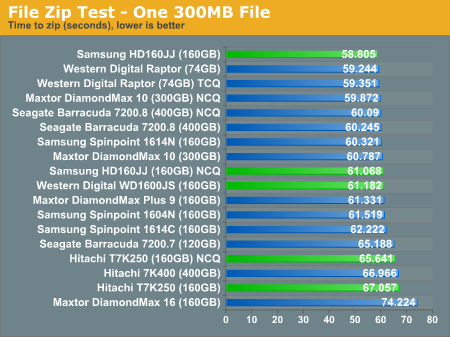
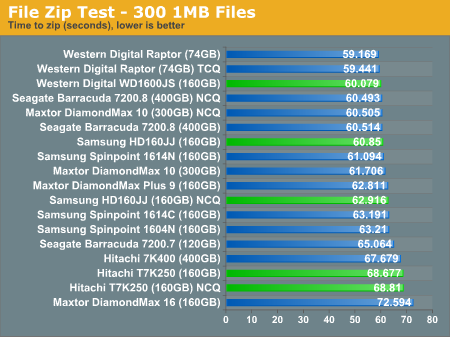
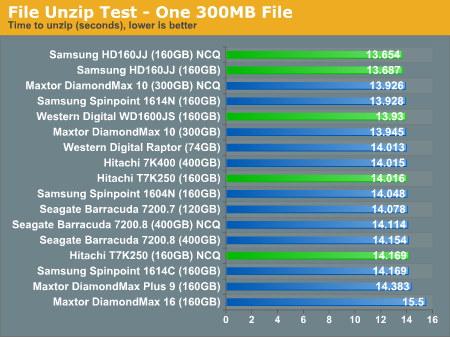
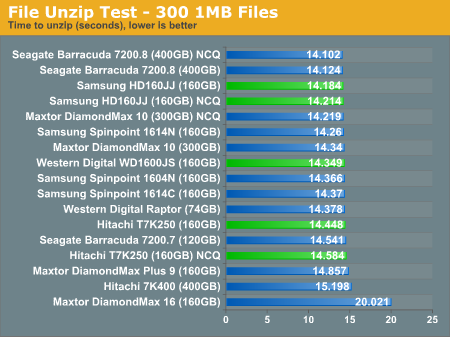

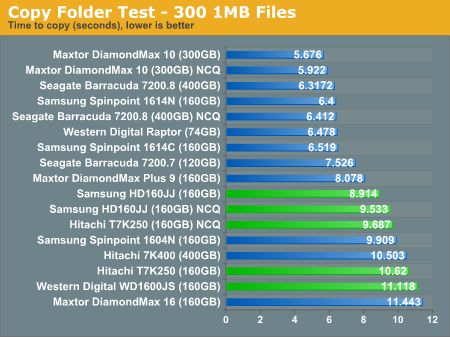
Our results for the file system task benchmarks did not really favor any of the SATA300 drives, but rather scattered the units across the charts. These tests show how each drive handles the various tasks of day to day file system operations.










52 Comments
View All Comments
Justin Case - Saturday, March 18, 2006 - link
Does anyone really believe Seagate 7200.8 drives can sustain 70 MB/s in the inner sectors? I have three of those and they struggle to reach 38 MB/s. Anyone with a clue about hard drives would have spotted a screw-up in the benchmarks (and this isn't the only one). Here is the full WinBench99 graph for a Seagate 7200.8:http://www.storagereview.com/articles/200504/20050...">http://www.storagereview.com/articles/200504/20050...
Anandtech is even less credible than Tom's Hardware, these days. What a joke. I hope Anand got a big fat check from Seagate for publishing this "review"...
PuravSanghani - Tuesday, June 28, 2005 - link
#24 & 25: Our apologies for such a delayed reply. The reason we used the older v6.39 driver is that it is the latest driver Giga-Byte has released on its website.Though Nvidia may have implemented newer features in the v6.54 release, the driver package the motherboard manufacturer has on their website is usually tested for their particular boards.
We will definitely look into the newer versions in the future to see if they provide any useful updates that apply to our review topic and use them accordingly.
PuravSanghani - Tuesday, June 28, 2005 - link
#44: By "% Difference" we mean the difference between the time it takes to zip the file as a task by itself and the time it takes to zip a file while Outlook is importing 400MB of emails into its Inbox.#45: They are there.
#48: The transfer rates are actually measured in MBytes/sec. But yes, the results are correct and the benchmarks have been run twice to confirm these numbers. Also, many of our readers have pointed out that the 3.0Gbp/sec transfer rates, or transfer rates higher than those we have encountered, are mainly achieved when the drives are setup in RAID arrays.
#49: Actually, our results are of the drive itself in a silent room with no PC fan or other hardware running. We turn off all other system fans and take sound readings 1" away from the side of each drive during its startup phase as well as during normal operation, specifically during Windows startup.
We will be sure to specify this in future reviews.
Sorry for the bulky reply, but I hope it helps.
Purav
yacoub - Tuesday, June 28, 2005 - link
#45 - Well, Anandtech's noise measurement is clearly pretty pointless if they all come out so close together. That generally means they aren't testing the drive itself for its noise output, but then entire case with whatever other noisy components are in there. Guess we'll have to wait for SilentPCReview to test the new drives to find out how quiet they are for those who -aren't- running 50decibel systems. =Ptinyabs - Tuesday, June 28, 2005 - link
Why does new drives have 60-70Mb of Begin transfer rate? Is that correct?BornStar18 - Tuesday, June 28, 2005 - link
LX-Did you miss page 13?
Zak - Monday, June 27, 2005 - link
Why using megabits per second in hard disk review if most people are used to megabytes? It's a bit confusing.-Z
LX - Monday, June 27, 2005 - link
Incomplete review.What about noise?
What about temperature?
ElFenix - Monday, June 27, 2005 - link
on page 12, is it just how i'm reading these or does it indicate that the % done is much better under multitasked than when only running the zip?yacoub - Monday, June 27, 2005 - link
Wow, that review left me somewhat uncertain.While reading it I started out liking the Hitachi best, but then around a third of the way through it started to suck, but then again near the end it looked good.
The Raptor still looked like the champ for the first third of the review, but then the 400GB Barracuda shined for a few tests (probably the important ones, surprisingly) such as Sustained Transfer Rate (where it blew away everything else though the 300GB DiamondMax 16MB came close) and Real World File System Tasks with the 300 1MB files, etc.
When it comes to thermals they all suck except for the DiamondMax drives, imho, and as far as acoustics go, forget it (get a drive suspension rig and isolation enclosure or get laptop HDs if you're really picky about noise).